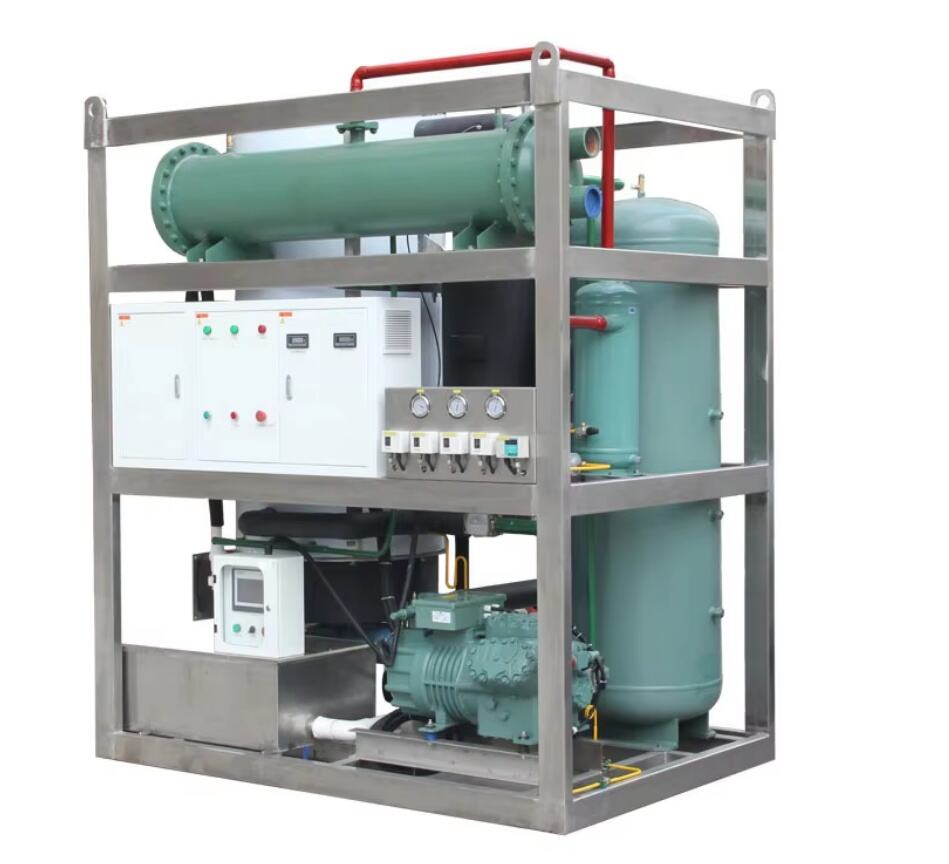The Role of Condensing Units in Refrigeration and HVAC Systems
How Condensing Units Enable Efficient Cooling in Refrigeration and AC Systems
The condensing unit sits at the heart of most refrigeration and AC systems, handling all that heat swapping needed to keep things cool. Let's break down what happens inside these machines. The whole process starts with the refrigeration cycle. First, compressors crank up the pressure on refrigerant gas, which makes it hotter. Then this hot gas heads over to those condenser coils where it gives off heat to whatever surroundings it's sitting in. As it cools down, the gas turns back into liquid form and makes its way through to the expansion valve. This setup lets technicians control temperatures pretty precisely across different environments. Looking at recent improvements, today's condensing units run anywhere between 18 to 35 percent more efficiently compared to similar models made just ten years back according to Department of Energy data from 2023. Manufacturers have been able to reach these gains largely because of better technology such as variable speed compressors and those new aluminum coils that resist corrosion much better than older materials did.
Integration of Condensing Units in Modern HVAC Technology
Modern HVAC systems rely on condensing units that handle both heating and cooling through what's called reverse cycle operation. When connected to IoT platforms, these units can actually change how much refrigerant flows around depending on what's happening outside and inside the building. The result? Studies show somewhere around a 20% cut in energy consumption for commercial properties. What makes this so valuable is the flexibility it brings. For instance, some setups combine geothermal heat pumps with regular air conditioning systems. This mix not only makes the whole system more reliable but also gets better performance out of each component involved.
Growing Demand for Compact Condensing Units in Urban Commercial Applications
Since 2020, urban sprawl has really pushed up demand for these compact condensing units by around 40%, particularly noticeable in places like supermarkets, eateries, and those massive data hubs where every square inch counts. The newer models with microchannel coils take up anywhere from 30 to 50 percent less room compared to older versions, yet they still deliver the same cooling power. Many businesses in crowded city environments are going for rooftop setups combined with ductless air handlers these days. This approach keeps valuable interior space free while still getting the job done when it comes to climate control.
Core Functionality and Key Components of Condensing Units

Understanding the Refrigeration Cycle: Compression, Condensation, Expansion, and Evaporation
Condensing units work using what's basically a four part thermodynamic process. First off, during compression stage the system boosts both pressure and temperature of that low pressure refrigerant vapor. When we get to condensation, the hot gas gives off heat as it moves through those coils in the condenser section, turning into a liquid under higher pressure. Then comes the expansion valve which carefully controls how much refrigerant gets sent to the evaporator. Here's where things get interesting - as the refrigerant evaporates, it pulls heat away from whatever area needs cooling, effectively finishing up the whole cycle. What makes these systems so effective is their closed loop design that allows for really accurate temperature regulation. According to recent studies by Ponemon (2023), newer models can actually perform about 35 percent better than their older counterparts thanks to improvements in how they manage this entire cycle throughout operation.
Heat Exchange Dynamics: The Critical Role of the Condenser Coil
Condenser coils serve as the main heat exchangers in these systems, typically handling around 60 to 70 percent of all the heat removal needed. These components are usually constructed from either copper or aluminum that resists corrosion, and they feature those distinctive fins on tubes which greatly increase the available surface area for air passing through. With recent improvements in computer modeling techniques known as CFD, manufacturers now produce coils that cut down on air resistance by approximately 22 percent while boosting heat transfer performance by about 18 percent compared to older designs. Maintenance remains critical though. Simple tasks like cleaning out accumulated dust and straightening bent fins can make a huge difference. Studies indicate that neglecting these basic steps might lead to efficiency drops approaching 30 percent over time due to just regular wear and tear plus debris accumulation.
Advancements in Condenser Design: Microchannel and High-Efficiency Coils
The new microchannel condenser coils with their parallel flat tube design instead of traditional round tubes actually increase heat rejection capabilities around 40 percent while using about 30 percent less refrigerant overall. These systems work really well when paired with variable speed fans and they're compatible with those newer A2L refrigerants too, which means they comply with all the upcoming 2024 federal energy regulations for commercial refrigeration equipment. Some high efficiency versions come equipped with smart hybrid cooling technology that switches seamlessly between air cooled and water cooled operations depending on what the surrounding temperature is doing. Field testing has shown this feature can cut down annual energy usage somewhere between 15 to maybe even 25 percent across different environments.
Maintenance Best Practices to Maximize Performance and Lifespan
Essential Routine Maintenance for Reliable Condensing Unit Operation
Regular maintenance keeps systems running at their best while making equipment last longer. One mustn't forget about cleaning coils four times a year since dirt buildup can slash efficiency by around 30% according to ASHRAE research from last year. Checking refrigerant levels monthly with proper tools is another essential task. Looking at electrical connections and how the compressor works twice a year helps cut down on energy costs by roughly 15%, plus it stops most mechanical problems before they happen. Don't overlook those fan motors either; they need lubrication after about 3,000 hours of operation. Filters and drain lines deserve special attention too, especially where humidity is high because mold and bacteria love damp conditions. When all this gets ignored, breakdowns become inevitable. Fixing things after they break down costs anywhere between four hundred fifty to seven hundred bucks each time in city businesses alone. That's money better spent on prevention than emergency calls.
Condensing vs. Noncondensing Technology: A Strategic Comparison
Design and Operational Differences Between Condensing and Noncondensing Systems
Condensing units work by capturing latent heat through secondary heat exchangers while noncondensing systems just let all that combustion heat escape. The difference matters because condensing models run at much cooler flue gas temps around 135 degrees Fahrenheit instead of the 350 degree mark seen in regular noncondensing units. This lower temperature helps cut down on thermal stress over time. Modern condensing systems also deal with the problem of acidic condensate by incorporating corrosion resistant alloys into their construction something that basic noncondensing equipment simply doesn't need to worry about since it lacks these advanced features altogether.
Energy Efficiency and Total Cost of Ownership: Long-Term Benefits of Condensing Units
Condensing systems achieve 92–98% thermal efficiency, outperforming noncondensing units, which operate at 80–85% efficiency (2024 HVAC Efficiency Report). Over a 10-year period, this translates to $12,000–$18,000 in energy savings for medium-sized commercial installations. Utility rebate programs in 34 U.S. states now offer incentives covering 20–40% of upfront costs, further improving return on investment.
Selecting the Right Technology Based on Application Scale and Industry Needs
| Factor | Condensing Units | Noncondensing Systems |
|---|---|---|
| Ideal System Capacity | 15+ tons | <10 tons |
| Annual Runtime | >3,000 hours | <1,500 hours |
| Climate Suitability | All regions | Mild/warm zones |
Food processing facilities with continuous cooling needs typically recoup their investment in condensing units within 2–3 years. In contrast, seasonal operations like ice rinks may favor the simplicity of noncondensing systems. Emerging hybrid designs combine a primary condensing unit with a noncondensing backup, offering operational flexibility and load balancing.
FAQs
What is the main function of a condensing unit?
The main function of a condensing unit is to facilitate heat exchange in refrigeration and HVAC systems, converting refrigerant gas into liquid form to maintain cooling efficiency.
Why are modern condensing units more efficient?
Modern condensing units are more efficient due to advancements such as variable speed compressors and aluminum coil designs that resist corrosion, allowing for better heat exchange and energy savings.
How does integrating IoT with condensing units improve efficiency?
Integrating IoT with condensing units allows for real-time adjustments in refrigerant flow based on external conditions, reducing energy consumption by approximately 20% in commercial settings.
What is the benefit of microchannel condenser coils?
Microchannel condenser coils improve heat rejection by about 40% while using less refrigerant, making systems more efficient and compliant with upcoming energy regulations.
How does regular maintenance affect condensing unit performance?
Regular maintenance, including coil cleaning and checking refrigerant levels, prevents efficiency drops and mechanical issues, reducing repair costs and improving lifespan.

